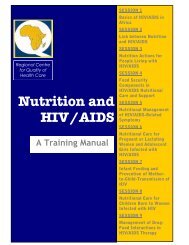2.1: Anthropometric Indicators Measurement Guide - Linkages Project
2.1: Anthropometric Indicators Measurement Guide - Linkages Project
2.1: Anthropometric Indicators Measurement Guide - Linkages Project
Create successful ePaper yourself
Turn your PDF publications into a flip-book with our unique Google optimized e-Paper software.
REFERENCES PART 9.<br />
Graph - A drawing that shows the<br />
relationship between two sets of numbers<br />
as a set of points having coordinates<br />
determined by their relationship; a display<br />
of numerical relationships.<br />
Growth chart - A graph that is usually<br />
used to record a child’s weight-for-age in<br />
months; a chart typically used by mothers<br />
and health workers to determine if a child<br />
is experiencing a normal gain in weight.<br />
Growth faltering - A condition identified<br />
by emphasizing the direction of growth<br />
obtained in serial recordings, rather than<br />
actual weight-for-age itself; signified by no<br />
change or an actual decrease in<br />
measurements. (ACC/SCN, 1990)<br />
Growth monitoring and promotion -<br />
The practice of following changes in a<br />
child’s physical development, by regular<br />
measurement of weight and sometimes of<br />
length with accompanying information to<br />
guide the care givers’ nutritional and<br />
related care.<br />
Histogram - A display that shows the<br />
number of observations and how often<br />
they occur, usually through the use of<br />
vertical bars and a horizontal base that is<br />
marked off in equal units.<br />
Household - One person who lives alone<br />
or a group of persons, related or<br />
unrelated, who share food or make<br />
common provisions for food and possibly<br />
other essentials for living; the smallest<br />
and most common unit of production,<br />
consumption and organization in<br />
societies.<br />
Index - An index is usually made up of<br />
two or more unrelated variables that<br />
are used together to measure an<br />
underlying characteristic.<br />
Indicator - A measure used at the<br />
population level to describe the proportion<br />
of a group below a cut-off point; example:<br />
30 percent of the region’s children are<br />
below -2 SD for height-for-age.<br />
Intrahousehold distribution - The<br />
distribution of food within a household;<br />
the act of determining what proportion of<br />
the total household food supply each<br />
member of the household receives.<br />
Length-for-age - An index of past or<br />
chronic nutritional status; an index<br />
which assesses the prevalence of<br />
stunting.<br />
Local events calendar - A calendar that<br />
reflects important local events and<br />
seasons that might help a parent pinpoint<br />
the birth date of their child.<br />
Longitudinal survey - A survey which<br />
follows people over time, to capture data<br />
on an evolving situation or problem.<br />
Different types of longitudinal surveys<br />
9.<br />
57

















